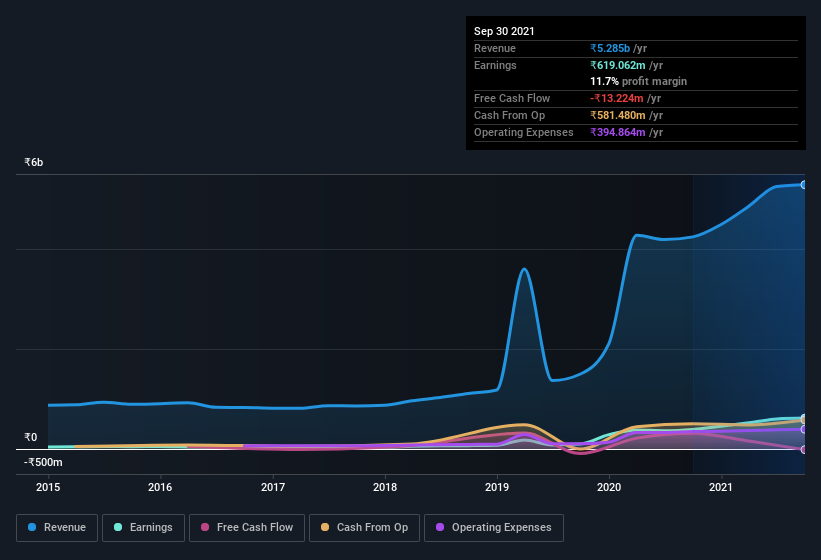HLE Glascoat's (NSE:HLEGLAS) Solid Profits Have Weak Fundamentals

HLE Glascoat Limited's (NSE:HLEGLAS) robust earnings report didn't manage to move the market for its stock. Our analysis suggests that this might be because shareholders have noticed some concerning underlying factors.
Check out our latest analysis for HLE Glascoat

Examining Cashflow Against HLE Glascoat's Earnings
As finance nerds would already know, the accrual ratio from cashflow is a key measure for assessing how well a company's free cash flow (FCF) matches its profit. In plain english, this ratio subtracts FCF from net profit, and divides that number by the company's average operating assets over that period. You could think of the accrual ratio from cashflow as the 'non-FCF profit ratio'.
As a result, a negative accrual ratio is a positive for the company, and a positive accrual ratio is a negative. While it's not a problem to have a positive accrual ratio, indicating a certain level of non-cash profits, a high accrual ratio is arguably a bad thing, because it indicates paper profits are not matched by cash flow. That's because some academic studies have suggested that high accruals ratios tend to lead to lower profit or less profit growth.
HLE Glascoat has an accrual ratio of 0.32 for the year to September 2021. Therefore, we know that it's free cashflow was significantly lower than its statutory profit, raising questions about how useful that profit figure really is. Over the last year it actually had negative free cash flow of ₹13m, in contrast to the aforementioned profit of ₹619.1m. We saw that FCF was ₹317m a year ago though, so HLE Glascoat has at least been able to generate positive FCF in the past. Notably, the company has issued new shares, thus diluting existing shareholders and reducing their share of future earnings.
Note: we always recommend investors check balance sheet strength. Click here to be taken to our balance sheet analysis of HLE Glascoat.
One essential aspect of assessing earnings quality is to look at how much a company is diluting shareholders. In fact, HLE Glascoat increased the number of shares on issue by 5.6% over the last twelve months by issuing new shares. As a result, its net income is now split between a greater number of shares. To celebrate net income while ignoring dilution is like rejoicing because you have a single slice of a larger pizza, but ignoring the fact that the pizza is now cut into many more slices. Check out HLE Glascoat's historical EPS growth by clicking on this link.
How Is Dilution Impacting HLE Glascoat's Earnings Per Share? (EPS)
As you can see above, HLE Glascoat has been growing its net income over the last few years, with an annualized gain of 820% over three years. In comparison, earnings per share only gained 396% over the same period. And at a glance the 58% gain in profit over the last year impresses. But in comparison, EPS only increased by 47% over the same period. And so, you can see quite clearly that dilution is influencing shareholder earnings.
In the long term, earnings per share growth should beget share price growth. So it will certainly be a positive for shareholders if HLE Glascoat can grow EPS persistently. But on the other hand, we'd be far less excited to learn profit (but not EPS) was improving. For that reason, you could say that EPS is more important that net income in the long run, assuming the goal is to assess whether a company's share price might grow.
Our Take On HLE Glascoat's Profit Performance
As it turns out, HLE Glascoat couldn't match its profit with cashflow and its dilution means that earnings per share growth is lagging net income growth. Considering all this we'd argue HLE Glascoat's profits probably give an overly generous impression of its sustainable level of profitability. So while earnings quality is important, it's equally important to consider the risks facing HLE Glascoat at this point in time. Every company has risks, and we've spotted 3 warning signs for HLE Glascoat (of which 1 is potentially serious!) you should know about.
Our examination of HLE Glascoat has focussed on certain factors that can make its earnings look better than they are. And, on that basis, we are somewhat skeptical. But there is always more to discover if you are capable of focussing your mind on minutiae. For example, many people consider a high return on equity as an indication of favorable business economics, while others like to 'follow the money' and search out stocks that insiders are buying. So you may wish to see this free collection of companies boasting high return on equity, or this list of stocks that insiders are buying.
Valuation is complex, but we're here to simplify it.
Discover if HLE Glascoat might be undervalued or overvalued with our detailed analysis, featuring fair value estimates, potential risks, dividends, insider trades, and its financial condition.
Access Free AnalysisThis article by Simply Wall St is general in nature. We provide commentary based on historical data and analyst forecasts only using an unbiased methodology and our articles are not intended to be financial advice. It does not constitute a recommendation to buy or sell any stock, and does not take account of your objectives, or your financial situation. We aim to bring you long-term focused analysis driven by fundamental data. Note that our analysis may not factor in the latest price-sensitive company announcements or qualitative material. Simply Wall St has no position in any stocks mentioned.
Have feedback on this article? Concerned about the content? Get in touch with us directly. Alternatively, email editorial-team (at) simplywallst.com.
About NSEI:HLEGLAS
HLE Glascoat
Manufactures and sells carbon steel glass lined equipment in India and internationally.
Proven track record with adequate balance sheet.
Similar Companies
Market Insights
Community Narratives



